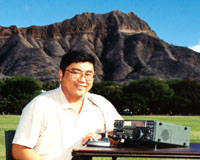
Amateur Radio in Hawaii
If you're travelling to Hawaii in the near future and you're an amateur radio operator qualified to operate on US VHF and UHF frequencies, you're welcome to visit and use some of the repeaters that are open to the visitors to our island state. These are open repeaters sponsored by amateur radio clubs and other organizations that are funded by members for the advancement of amateur radio and amateur radio-based emergency communications.
Enjoy, and feel free to drop me an e-mail if you have any questions.
On Oahu, visit the EARC (Emergency Amateur Radio Club) repeaters on 146.88- (Diamond Head), 146.80- (Mauna Kapu/Makakilo), and 146.98- (Municipal Building/City Hall). Typically, you'll find EARC members monitoring these repeaters and welcoming visitors, especially the Diamond Head 146.88 repeater.
The Diamond Head repeater covers from Hawaii Kai to Ewa, Central Oahu till Wahiawa and parts of the Windward area. The Mauna Kapu repeater covers much of the Waianae Coast, Ewa plains, and metropolitan Honolulu until Kaimuki and Diamond Head.
There is a nightly EARC net at 7:30 pm each evening. On Sunday through Wednesday and Friday evenings, it is held on the 146.88 MHz repeater. On Thursday and Saturdays, it's held on the 146.80 MHz repeater. There is also a swap-and-shop net on Tuesday evenings, 8:00 pm on 146.88 and at 8:30 pm on 147.28.
There are other open repeaters you can access. Click on this link to find out more.
If you're into world records for VHF and UHF trans-oceanic propagation, check out KH6HME's Web page. The KH6HME beacons spots site lists real-time reports from other stations, primarily in southern California and Mexico that listen for trans-Pacific tropo ducting of the KH6HME beacons located on the slopes of Mauna Loa. Click on this link if you need a map of the State of Hawaii with the Maindenhead Grid Squares. One interesting observation is that each of the four main populated islands in Hawaii is in at least two (Kauai and Oahu), and sometimes three (Maui) or four (Big Island) grid squares.
Relive the original excitement of July 8, 1957 as
W6NLZ and KH6UK shatter the two meter distance record
as captured in this
ARRL QST column and article.

The continuing efforts of KH6UK
are captured in this series of articles from CQ VHF Magazine;
Part 1,
Part 2 and
Part 3.

On occassion, you can hear SSB activity on 144.200. There used to be more activity in the late 1970s, when the Kenwood TS-700s were around. These days, you're likely to hear the occassional experiment from owners of the new HF/VHF/UHF multi-band radios such as the FT-817, FT-857, IC-706 and IC-7000.
A number of hams do VHF/UHF space communications, including contacting the International Space Station. Click on this link to find out more.
A small handful of hams do 1296 Mhz communications. Click on this link to find out more.
If you are interested in D-STAR in Hawaii, click on this link to find out more.
A small handful of hams do ATV (amateur television) communications. I do not have a lot of information on specific operators.
On rare occassions, someone comes to Hawaii and does an EME DXpedition. Bob Jones, KH6O, used to do EME but he passed away a number of years ago. Bruce Clark, K0YW held an EME operation on 1.2 and 2.3 GHz in April 2007. click on this link to find out more.
Copyright © 1997-2015 Ron Hashiro
Updated: Sept 4, 2012 DISCLAIMER: Ron Hashiro Web Site is not responsible for the content at
any of the external sites that we link to and therefore
are not necessarily endorsed by us.
